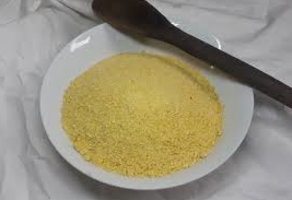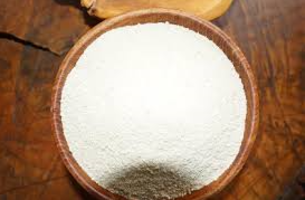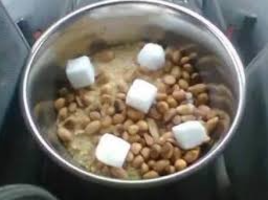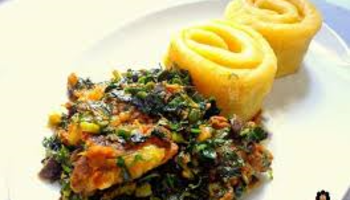Have you ever wondered about that delicious, stretchy food you see Nigerians enjoying with their soups? That smooth, satisfying meal that brings families together around the dinner table? You’re looking at eba, one of West Africa’s most cherished staple foods made from garri.
Garri, the cassava flour that transforms into eba, represents more than just food – it’s a cultural bridge connecting generations, regions, and communities across Nigeria and beyond. Today, we’ll journey through everything you need to know about creating perfect eba, from understanding garri to mastering the art of preparation.
Understanding Garri: The Foundation of Great Eba
Garri is processed cassava flour, created through a traditional method of grating, pressing, fermenting, and roasting fresh cassava roots. This process removes toxins naturally present in raw cassava while creating the distinctive slightly sour taste that makes garri unique.

Types of Garri Available
- White Garri – Mild flavor, smooth texture, perfect for beginners
- Yellow Garri – Enhanced with palm oil during processing, richer taste
- Ijebu Garri – Fine texture, premium quality from Ogun State
- Bendel Garri – Coarser texture, traditional preparation method
The quality of your garri directly impacts your eba’s taste and texture. Fresh garri should feel dry to the touch, have a pleasant aroma, and show no signs of mold or unusual discoloration. When stored properly, quality garri can last several months, making it an excellent pantry staple.

Essential Equipment for Making Perfect Eba
Success in making eba starts with having the right tools. While traditional preparation might use a wooden spoon and clay pot, modern kitchens offer practical alternatives that deliver excellent results.
Required Equipment
- Heavy-bottomed saucepan
- Wooden spoon or spatula –
- Measuring cups –
- Clean kitchen towel
- Serving bowl
Optional but Helpful
- Non-stick pan
- Heat-resistant gloves
- Traditional clay pot
Basic Eba Recipe
The process seems simple, but achieving the perfect consistency takes understanding the relationship between heat, water, and garri.
Ingredients
- 1 cup quality garri
- 2 to 2.5 cups clean water
- Pinch of salt (optional)
Detailed Preparation Method
Step One: Water Preparation
Pour your measured water into a heavy-bottomed saucepan. The water amount depends on your desired consistency – less water creates firmer eba, while more water produces softer texture. Let the water boil over, this initial boiling removes any impurities and ensures proper temperature for garri integration.
Step Two: Garri Introduction
Lower the heat to medium-low after the water reaches an energetic boil. Begin adding garri gradually, starting with small amounts. Pour in roughly one-quarter of your measured garri while stirring continuously with your wooden spoon. Smooth integration is ensured and lumping is avoided with this gradual addition.
Step Three: Continuous Mixing
Stir the mixture constantly as you add remaining garri. The consistency will begin changing from liquid to paste-like texture. Keep stirring energically to break up any lumps that develop. This stage requires constant attention – stopping too early results in lumpy eba, while over-mixing can make it too smooth.
Step Four: Achieving Perfect Consistency
Add remaining garri slowly while maintaining constant stirring motion. The mixture will thicken significantly. You’ll know you’re approaching the right consistency when the eba begins pulling away from the sides of the pan and forms a cohesive mass around your spoon.
Step Five: Final Cooking
Continue cooking and stirring for 3-5 minutes after reaching desired consistency. This final cooking stage ensures all garri particles are properly hydrated and cooked through. The eba should be smooth, stretchy, and hold its shape when formed into balls.
Step Six: Taking a Break and Serving
Take off the heat and give the eba two to three minutes to rest. This brief resting period allows the texture to settle and makes it easier to handle. Using wet hands or a spoon, form eba into serving portions.
Advanced Techniques for Superior Eba
Mastering basic eba preparation opens doors to exploring advanced techniques that elevate this simple dish into something extraordinary.
Cold Water Method
Some experienced cooks prefer starting with cold water mixed with garri before heating. This method involves:
Step One: Mix garri with cold water to form a smooth paste
Step Two: Place mixture over medium heat
Step Three: Stir continuously as mixture heats and thickens
Step Four: Continue cooking until desired consistency achieved
This technique often produces smoother eba with fewer lumps, making it excellent for beginners still developing their stirring skills.
Double Cooking Method
For extra smooth eba, try the double cooking approach:
Preparation: Make eba using standard method but slightly undercook
Rest Period: Allow eba to cool for 10-15 minutes
Reheating: Return to low heat with small amount of water
Final Mixing: Stir gently until reaching perfect consistency. This method requires more time but produces exceptionally smooth, professional-quality eba.
Temperature Control and Cooking Tips
Mastering temperature control separates good eba from exceptional eba. Understanding how heat affects the cooking process helps you achieve consistent results every time.
Heat Management Strategies
- Start High, Finish Low – Begin with boiling water, reduce to medium-low for mixing
- Consistent Heat – Avoid temperature fluctuations that create uneven cooking
- Residual Heat – Use pan’s retained heat for final texture development
- Cool Down Control – Gradual cooling prevents skin formation on surface
Storage Solutions and Meal Planning
Understanding proper storage extends eba’s usability and helps with meal planning for busy households.
Short-term Storage
Immediate Consumption: Keep eba warm by covering with clean kitchen towel. Properly made eba stays fresh and pliable for 2-3 hours at room temperature, making it perfect for family meals where people eat at different times.
Same-Day Storage: Wrap individual portions in plastic wrap or store in covered containers. Refrigerated eba keeps for 24-48 hours and can be gently reheated with small amounts of warm water.
Long-term Storage Solutions
Freezing Method:
- Form eba into individual serving portions
- Wrap each portion tightly in plastic wrap
- Place wrapped portions in freezer bags
- Label with date and use within 3 months
- Thaw overnight in refrigerator before reheating
Reheating Techniques:
- Microwave Method – Add tablespoon of water, heat in 30-second intervals
- Stovetop Method – Place in pan with small amount of water over low heat
- Steam Method – Place in steamer basket over simmering water
Troubleshooting Common Issues
Even experienced cooks encounter challenges when making eba. Understanding common problems and their solutions helps you achieve consistent results.
Lumpy Eba Solutions
Prevention:
- Add garri gradually while stirring continuously
- Maintain proper water temperature throughout cooking
- Use adequate mixing techniques from start to finish
Correction:
- Press lumps against pan sides while stirring
- Add small amounts of hot water to help break down lumps
- Continue stirring patiently until smooth
Too Soft or Too Hard Eba
Too Soft Issues:
- Cause – Too much water or insufficient garri
- Solution – Add more garri gradually while stirring
- Prevention – Measure ingredients carefully, adjust ratios based on garri type
Too Hard Problems:
- Cause – Insufficient water or overcooking
- Solution – Add warm water gradually while stirring gently
- Prevention – Monitor cooking time, start with recommended water ratios
Sticking and Burning Problems
Prevention Strategies:
- Use heavy-bottomed pans for even heat distribution
- Maintain appropriate heat levels throughout cooking
- Stir consistently to prevent bottom scorching
- Add water gradually to maintain proper consistency
Recovery Methods:
- Remove from heat immediately if sticking occurs
- Add small amounts of water to loosen mixture
- Transfer to clean pan if necessary to prevent further burning
Nutritional Benefits and Health Considerations
Eba provides substantial nutritional value, making it an excellent energy source for active individuals and growing families.
Nutritional Profile
- Carbohydrates – Primary energy source, approximately 30-35 grams per serving
- Fiber – Supports digestive health and satiety
- Calories – Moderate caloric density, typically 150-200 calories per serving
- Minerals – Contains potassium, calcium, and trace minerals from cassava
Health Benefits
- Gluten-Free – Safe for individuals with celiac disease or gluten sensitivity
- Easy Digestion – Gentle on stomach, suitable for various age groups
- Sustained Energy – Complex carbohydrates provide lasting energy
- Versatile Base – Pairs with nutrient-rich vegetables and protein sources
Dietary Considerations
- Portion Control – Monitor serving sizes for weight management
- Balanced Meals – Combine with vegetables and proteins for complete nutrition
- Blood Sugar – Diabetics should monitor portions and pair with fiber-rich foods
Cultural Context and Regional Variations
Understanding eba’s cultural significance enhances appreciation for this traditional food and connects you with West African culinary heritage.
Regional Preferences
Nigerian Regions
- Southwest – Prefers slightly firmer texture, often served with vegetable soups
- Southeast – Enjoys softer consistency, paired with rich palm nut soups
- North – Less common but gaining popularity, adapted to local taste preferences
International Adaptations
- Diaspora Communities – Modified techniques using available ingredients
- Fusion Cooking – Combined with non-traditional soups and stews
- Restaurant Preparations – Standardized recipes for consistent commercial production
Traditional Serving Methods
Family Style: Eba traditionally serves multiple people from a central bowl, with each person taking portions to enjoy with communal soups and stews.
Individual Portions: Modern serving often involves individual portions shaped into balls or mounds, accompanied by personal soup bowls.
Special Occasions: During celebrations, eba might be prepared in larger quantities and served alongside multiple soup varieties, allowing guests to experience different flavor combinations.
Garri can be enjoyed in several delicious ways:

- Soaked garri – For a cool beverage or lunch, mix garri with cold water and add sugar, milk, groundnuts, coconut, or fruits like pineapple and banana.
- Eba – Mix hot garri with boiling water to form a smooth, stretchy dough that serves as swallow for soups
- Garri and beans – Combine with cooked beans, add palm oil, onions, and pepper for a complete meal
- Garri bread – Some people eat it dry as a crunchy snack, though this requires drinking plenty of water
- Garri porridge – Cook with vegetables, fish, or meat to make a hearty porridge meal

Nigerian soups perfect for garri swallow (eba)
- Egusi soup: Made with protein, veggies, and pulverized melon seeds
Ogbono soup, which is made thicker by grinding African mango seeds - Okra soup – Fresh or dried okra with assorted meat and fish
- Bitter leaf soup (Ofe Onugbu) – Popular Igbo soup with bitter leaves and protein
- Afang soup – Combination of afang and water leaves with assorted meat
- Ewedu soup – Yoruba soup made from jute leaves, often paired with gbegiri
- Gbegiri soup – Bean-based soup that complements ewedu
- White/Pepper soup – Spicy broth with fish, meat, or chicken
- Vegetable soup – Made with various leafy greens like ugwu or spinach
- Banga soup – Palm fruit soup popular in the Niger Delta region
These soups are typically eaten by using the eba (or other swallow) to scoop up the soup with your hands.

FAQs
Can I make eba without garri?
While garri is the traditional and authentic ingredient for eba, some people experiment with alternatives in emergency situations. Cassava flour or tapioca flour can produce similar textures, but the taste and authenticity differ significantly.
For genuine eba experience, garri remains irreplaceable. The fermentation process that garri undergoes creates unique flavors and textures that other cassava products cannot replicate.
How long does homemade eba last?
Freshly made eba tastes best when consumed immediately but can be stored safely for 24-48 hours in the refrigerator. For longer storage, properly wrapped eba can be frozen for up to three months.
When storing, ensure eba is completely cooled before refrigerating to prevent condensation, which can affect texture. Reheating requires adding small amounts of water and gentle warming to restore original consistency.
Why is my eba sticky or slimy?
Sticky or slimy eba typically results from using too much water, insufficient cooking time, or poor quality garri. Overcooking can also create unwanted texture changes. To prevent this, measure water carefully, ensure your garri is fresh and dry, and cook for appropriate duration while stirring consistently.
If your eba becomes sticky, try adding small amounts of dry garri while stirring to absorb excess moisture.
Can I make eba in advance for meal prep?
Make individual portions, wrap tightly, and refrigerate for same-day consumption or freeze for longer storage. When meal prepping, slightly undercook eba since reheating continues the cooking process.
This advance preparation works well for busy schedules, though freshly made eba always provides the best taste and texture experience.
What’s the difference between white and yellow garri for eba?
White garri produces neutral-flavored eba with clean taste, while yellow garri creates richer, slightly more flavorful eba due to palm oil added during processing. Yellow garri often has slightly different texture properties and may require minor adjustment to water ratios.
Both types work excellently for eba, with choice depending on personal preference and intended soup pairings. Beginners often find white garri more forgiving for learning proper techniques.
Conclusion…
Learning how to make garri (eba) at home connects you with centuries of West African culinary tradition while providing practical skills for creating satisfying, nutritious meals. Whether you’re preparing eba for a family dinner, introducing friends to Nigerian cuisine, or simply exploring new culinary territories, the skills you’ve learned here will serve you well.
This humble dish has nourished generations and continues bringing people together around tables worldwide. Now you have the tools, techniques, and understanding to join this tradition, creating your own eba memories one perfect batch at a time.
